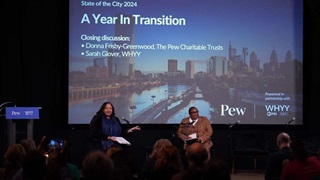Honduras’ Coastal Wetlands: Important for Biodiversity, Climate, and the Country’s People
Jimmy Andino and Alejandra Ramirez believe that improving policies and management practices can help preserve these valuable ecosystems

Biologist Jimmy Andino has dedicated much of his professional life to protecting the marine resources of Honduras, with more than a decade at the Center for Marine Studies (CEM, for its Spanish abbreviation). As executive director of the CEM, Andino—together with Alejandra Ramírez, the organization’s climate governance coordinator—has led recent efforts to ensure that ongoing coastal wetland research and conservation lead to better management of these ecosystems, a more ambitious Nationally Determined Contribution (the commitments governments make to reduce global emissions and the effects of climate change), and input from local communities.
This interview has been edited for clarity and length.
What role has the Center for Marine Studies played in protecting Honduras’ marine ecosystems?
Andino: For 14 years, the Center for Marine Studies (CEM) has promoted a responsible and sustainable fishery, which has ensured that more than 4,500 families in Honduran coastal communities can make a living from fishing—with an income that exceeds the national minimum wage—allowing them to cover the education and health expenses of their children. This was achieved by managing marine ecosystems in Honduras and by protecting 500 square kilometers (nearly 200 square miles) of marine habitat, which helps shield the region’s biodiversity from the effects of climate change and helps conserve marine species as the primary food source for thousands of people in the region. In this way, the CEM is helping the national government, local authorities, civil society, and fishers make better decisions about resource management.
How has Honduras fared historically in terms of conserving coastal wetlands?
Andino: Honduras has about 4,600 square miles of wetlands—about three times the size of the state of Rhode Island—of which mangroves cover about 200 square miles distributed in four coastal regions: the Bay Islands, Atlantic, La Mosquitia, and Pacific. Taken together, four species of mangroves—Rhizophora mangle (red mangrove), Laguncularia racemosa (white mangrove), Avicennia germinans (black mangrove), and Conocarpus erectus (button mangrove)—account for 1% of the country’s total forest cover.
Mangroves are globally important coastal ecosystems that develop in the coastal zone of tropical and subtropical countries, in areas where seawater mixes with water from rivers, lagoons, and underground springs. They generate multiple environmental goods and services used by human populations. For example, because of their ability to sequester and store large amounts of carbon in their sediments and vegetation, mangrove ecosystems are key nature-based solutions to the challenges posed by climate change. According to the National Institute of Forest Conservation and Development of Honduras, from 2017 to 2022 Honduran mangroves on average stored 346.7 tons of carbon per hectare (nearly 2.5 acres).
In terms of governance, Honduras has constructed policies and set up international goals to ensure the protection of coastal wetlands. A National Policy on Wetlands and Coastal Marine Spaces of Honduras (2019-2029) is available as a regulatory framework for the conservation of marine/coastal habitats, and international commitments are in the framework of Nationally Determined Contributions.
Mangroves offer other important benefits for Honduras, beyond carbon sequestration. Isn’t that right?
Andino: Yes. These ecosystems are vital for the coastal communities that inhabit them and for those communities that develop in the highlands, and they directly and indirectly benefit terrestrial and aquatic flora and fauna.
Honduras has mangroves on both coasts and hundreds of coastal communities and cities that depend directly on ecosystem services, such as:
- Protection against storms and other weather events.
- Water regulation (aquifer recharge and water filtration).
- Mitigation of sea level rise.
- Shoreline stabilization and coastal erosion control.
- Retention, assimilation, and transformation of nutrients.
- Retention of sediment, carbon, and pollutants.
- Habitat for a great diversity of species of fish, crustaceans, mollusks, mammals, reptiles, amphibians, and birds, some of them commercially important or endangered.
- Maintenance of fisheries in which about 75% of commercial fishing species spend part of their life cycle in mangroves, or depend on mangroves for food.
Ramírez: Mangroves provide several environmental benefits, such as protection from hurricanes and storms, and the purification and regulation of water flow. They serve as a refuge for migratory species. They’re also a means of obtaining food and income: For example, in southern Honduras, a local mollusk that provides a source of income for entire families—who gather and sell the mollusks—grows and is produced in the mangroves. Mangroves are also a source of income in the tourism sector, where groups of boatmen take tourists to contemplate the wonderful landscapes of the mangroves.
Yet there’s a lot that we still don’t know about mangroves.
Andino: That’s right. Research on mangrove ecosystems is scarce in most countries, and Honduras is no exception. In Honduras, there is little documented information at the national level on the current state of mangroves, because studies have been isolated or focused on specific areas or regions. Several of these studies have been developed by short-term projects and educational institutions.
So because we only have data at a local scale—or sometimes national statistics extrapolated from regional sources in Central America—it’s a priority to generate information at the national level on blue carbon in mangrove ecosystems in Honduras.
The goal is to have tools that allow the dissemination of current knowledge of mangrove ecosystems in the country and report on the distribution, forest characteristics, and carbon stored in these ecosystems. Likewise, we want to have a technical instrument to support informed decision-making about the conservation and sustainability of mangrove ecosystems in Honduras.
What challenges does Honduras face in protecting and restoring these ecosystems?
Andino: Degradation of mangrove forests, and changes in land use in these forests, run the risk of emitting carbon into the atmosphere. That’s why we need to identify the various carbon stores in mangroves at local, regional, and national levels, so we can develop specific conservation, management, and restoration strategies.
Another challenge is the lack of—or little enforcement of—wetland management policies and mangrove protection laws on the part of national authorities. There are national agreements and local regulations in the country, and Honduras is a signatory to international conventions on the protection of wetlands and mangroves. But degradation, deforestation, mangrove cutting for urbanization and coastal infrastructure, dredging, and urban pollution still persist as a result of a lack of planning in coastal marine areas that hinders effective management of the mangrove ecosystem.
How did you end up working at CEM and in the conservation of marine ecosystems?
Andino: As a Honduran biologist focused on biodiversity conservation, protecting marine resources was a life decision for me. In my 13 years in coastal marine resource management in Honduras, I recognize the importance of ecosystems as critical habitats for the survival of species, but I also recognize that coastal marine ecosystems (such as the mangrove) are very important ecosystems for the benefits they provide to coastal communities and cities, and to the thousands of fishing families whose livelihoods are linked to the mangrove system.
Ramírez: After years of working on climate change projects, I was invited to be part of the CEM team to help meet the marine-coastal ecosystem conservation goals by focusing on the country’s climate governance. I’ve had the joy of working on both climate change mitigation and adaptation before, and I hope to make my mark on protecting the country’s natural resources.
How will your new partnership with The Pew Charitable Trusts support Honduras in the conservation of these ecosystems?
Andino: This Pew project in Honduras aims to strengthen public policies to improve mangrove management in Honduras by identifying gaps in data collection information on mangroves. Likewise, the project is designed to help record the contributions of mangroves in blue carbon measurements as part of Honduras’ goals for its 2025 Nationally Determined Contributions.
The project also seeks to connect and facilitate strategic communication between the various government entities working on mangrove and climate management and achieve greater fluidity in the exchange of communication—and use and interpretation of mangrove and blue carbon data—to contribute to national reports and international commitments.
This project also seeks to empower and strengthen several multisectoral entities, such as the Interinstitutional Committee for the Environmental and Protected Areas of the Tela region, to achieve better mangrove governance in Honduras.
What do you think this new line of work can bring to coastal communities?
Andino: With its focus on local involvement, this project can ensure that coastal communities continue to strengthen their active participation in mangrove protection and management activities, recognizing their role as those responsible to the world for conserving mangroves—the vulnerable ecosystems on which we all depend. These communities will be participating in negotiation, discussion, and decision-making with other national actors and authorities, and their opinions will be heard and taken into account in the management of mangrove ecosystems.
Is there anything else you’d like to add about Honduras’ aspirations in coastal ecosystem conservation and national climate policies?
Ramírez: The protection of wetlands and other coastal ecosystems has been added to the list of priorities in government policies, with different Honduran institutions working together to define the most conducive routes to implement true conservation actions.
Andino: Honduras is a country blessed with a high biodiversity of tropical marine coastal ecosystems. So we must act and be responsible for good management, guaranteeing interdisciplinary collaboration in the creation of effective and strategic high-impact public policies that preserve the ecological integrity of these coastal ecosystems. The protection of these ecosystems is vital, so that they continue to provide environmental services on a global and national scale for the enjoyment of present and future generations.
The future is now. We must act and do our part; together we can make a difference.
Spotlight on Mental Health
MORE FROM PEW
Explore Pew’s new and improved
Fiscal 50 interactive
Your state's stats are more accessible than ever with our new and improved Fiscal 50 interactive:
- Maps, trends, and customizable charts
- 50-state rankings
- Analysis of what it all means
- Shareable graphics and downloadable data
- Proven fiscal policy strategies
Welcome to the new Fiscal 50
Key changes include:
- State pages that help you keep track of trends in your home state and provide national and regional context.
- Interactive indicator pages with highly customizable and shareable data visualizations.
- A Budget Threads feature that offers Pew’s read on the latest state fiscal news.














